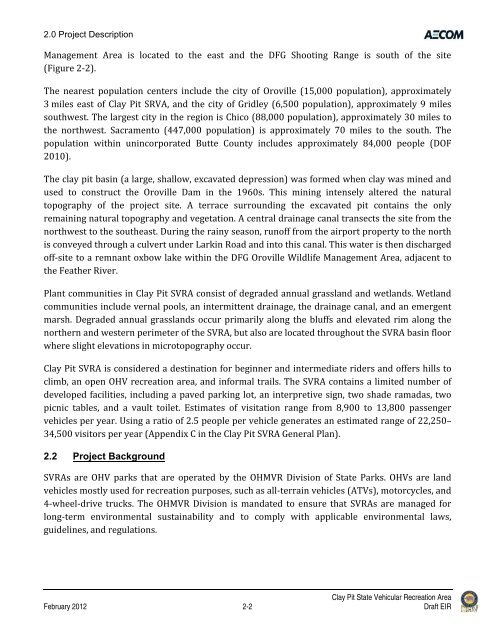Draft Environmental Impact Report - California Off Highway Vehicle ...
Draft Environmental Impact Report - California Off Highway Vehicle ...
Draft Environmental Impact Report - California Off Highway Vehicle ...
Create successful ePaper yourself
Turn your PDF publications into a flip-book with our unique Google optimized e-Paper software.
2.0 Project Description<br />
Management Area is located to the east and the DFG Shooting Range is south of the site<br />
(Figure 2‐2).<br />
The nearest population centers include the city of Oroville (15,000 population), approximately<br />
3 miles east of Clay Pit SRVA, and the city of Gridley (6,500 population), approximately 9 miles<br />
southwest. The largest city in the region is Chico (88,000 population), approximately 30 miles to<br />
the northwest. Sacramento (447,000 population) is approximately 70 miles to the south. The<br />
population within unincorporated Butte County includes approximately 84,000 people (DOF<br />
2010).<br />
The clay pit basin (a large, shallow, excavated depression) was formed when clay was mined and<br />
used to construct the Oroville Dam in the 1960s. This mining intensely altered the natural<br />
topography of the project site. A terrace surrounding the excavated pit contains the only<br />
remaining natural topography and vegetation. A central drainage canal transects the site from the<br />
northwest to the southeast. During the rainy season, runoff from the airport property to the north<br />
is conveyed through a culvert under Larkin Road and into this canal. This water is then discharged<br />
off‐site to a remnant oxbow lake within the DFG Oroville Wildlife Management Area, adjacent to<br />
the Feather River.<br />
Plant communities in Clay Pit SVRA consist of degraded annual grassland and wetlands. Wetland<br />
communities include vernal pools, an intermittent drainage, the drainage canal, and an emergent<br />
marsh. Degraded annual grasslands occur primarily along the bluffs and elevated rim along the<br />
northern and western perimeter of the SVRA, but also are located throughout the SVRA basin floor<br />
where slight elevations in microtopography occur.<br />
Clay Pit SVRA is considered a destination for beginner and intermediate riders and offers hills to<br />
climb, an open OHV recreation area, and informal trails. The SVRA contains a limited number of<br />
developed facilities, including a paved parking lot, an interpretive sign, two shade ramadas, two<br />
picnic tables, and a vault toilet. Estimates of visitation range from 8,900 to 13,800 passenger<br />
vehicles per year. Using a ratio of 2.5 people per vehicle generates an estimated range of 22,250–<br />
34,500 visitors per year (Appendix C in the Clay Pit SVRA General Plan).<br />
2.2 Project Background<br />
SVRAs are OHV parks that are operated by the OHMVR Division of State Parks. OHVs are land<br />
vehicles mostly used for recreation purposes, such as all‐terrain vehicles (ATVs), motorcycles, and<br />
4‐wheel‐drive trucks. The OHMVR Division is mandated to ensure that SVRAs are managed for<br />
long‐term environmental sustainability and to comply with applicable environmental laws,<br />
guidelines, and regulations.<br />
Clay Pit State Vehicular Recreation Area<br />
February 2012 2-2 <strong>Draft</strong> EIR








